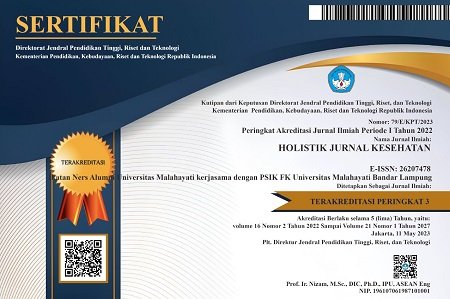Perbandingan kualitas dokumentasi keperawatan berbasis elektronik dan berbasis kertas: Study literature
Abstract
Paper‐based versus electronic‐based of health records in quality of nursing documentation: A literature review study.
Background: Many technological developments in nursing services have emerged, one of them is electronic-based nursing documentation. The electronic nursing documentation has a good impact which increases the quality of service. But the readiness is still questionable.
Purpose: Describing the quality comparison of electronic-based nursing documentation and paper-based nursing documentation.
Method: This study uses a PRISMA literature review. Through the remote-lib.ui.ac.id database that is connected to various scientific publication pages such as, Scopus, Ebsco, PROQUEST Scholar-Articles with several key words such as electronic nursing documentation, nursing paper documentation, management information systems.
Results: Electronic-based documentation has a higher level of quality documentation than paper-based documentation in terms of efficiency, effectiveness, patient focus and timeliness.
Conclusion: Electronic-based documentation offers the optimization of nursing care, effective and efficient documentation, integrated nursing care and cost-effective through (paperless). Strong support from hospital institutions, organizations and government at the beginning of the nurse adaptation system and process is a challenge so that the application of electronic nursing documentation is realized properly.
Keywords: Paper‐based; Electronic‐based; Health records; Quality; Nursing documentation.
Pendahuluan: Pengembangan teknologi dalam pelayanan keperawatan banyak bermunculan, salah satunya dokumentasi keperawatan berbasis elektronik. Dokumentasi keperawatan elektronik memberikan dampak baik yang luarannya meningkatkan kualitas pelayanan. Namun kesiapan masih dipertanyakan.
Tujuan: Menggambarkan perbandingan kualitas dokumentasi keperawatan berbasis elektronik dan dokumentasi keperawatan berbasis kertas.
Metode: Penelitian ini menggunakan tinjauan pustaka PRISMA. Melalui Database remote-lib.ui.ac.id yang terhubung dengan berbagai macam laman publikasi ilmiah seperti, Scopus, Ebsco, PROQUEST, Scholar-Artikel dengan beberapa kata kunci seperti dokumentasi keperawatan elektronik, dokumentasi keperawatan kertas, sistem informasi manajemen.
Hasil: Dokumentasi berbasis elektronik memiliki tingkat kualitas dokumentasi lebih dibandingkan dokumentasi berbasis kertas secara efesiensi, efektifitas, fokus pada pasien maupun ketepatan waktu.
Simpulan: Dokumentasi berbasis elektronik menawarkan keoptimalan melakukan asuhan keperawatan, dokumentasi efektif dan efesien, asuhan keperawatan terintegrasi serta cost-effective melalui (paperless). Dukungan kuat dari institusi rumah sakit, organisasi maupun pemerintah dalam permulaan sistem dan proses adaptasi perawat menjadi tantangan, agar penerapan dokumentasi keperawatan elektronik terealisasi dengan baik.
Keywords
Full Text:
PDFReferences
Adereti, C. S., & Olaogun, A. A. (2018). Use of Electronic and Paper-based Standardized Nursing Care Plans to Improve Nurses’ Documentation Quality in a Nigerian Teaching Hospital. International Journal of Nursing Knowledge. doi:10.1111/2047-3095.12232
Akhu‐Zaheya, L., Al‐Maaitah, R., & Bany Hani, S. (2018). Quality of nursing documentation: Paper‐based health records versus electronic‐based health records. Journal of Clinical Nursing, 27(3-4), e578-e589. doi:10.1111/jocn.14097
Atasoy, H., Greenwood, B. N., & McCullough, J. S. (2019). The Digitization of Patient Care: A Review of the Effects of Electronic Health Records on Health Care Quality and Utilization. Annual Review of Public Health, 40(1), 487-500. doi:10.1146/annurev-publhealth-040218-044206
Baumann, L. A., Baker, J., & Elshaug, A. G. (2018). The impact of electronic health record systems on clinical documentation times: A systematic review. Health policy, 122(8), 827-836. doi:10.1016/j.healthpol.2018.05.014
Dwisatyadini, M. (2014). Pengaruh Penerapan Simpro Terhadap Kelengkapan dan Efisiensi Waktu Dokumentasi Keperawatan di Instalasi Rawat Jalan RST Dompet Dhuafa Parung. Universitas Indonesia, Jakarta.
Hariyati Rr. T, Y. A., Eryando T, Hasibuan Z., & Milanti A. (2016). The Effectiveness and Efficiency of Nursing Care Documentation Using the SIMPRO Model. International of journal nursing knowledge, 27.
Hariyati, T. S., Kobayashi, N., Sahar, J., & Nuraini, T. (2018). Simplicity and Completeness of Nursing Process Satisfaction Using Nursing Management Information System at the Public Health Service “X” Indonesia. International Journal of Caring Sciences, 11(2), 1034.
Kazley AS, A. S., KN Simpson, & Teufel R. (2014). Association of electronic health records with cost savings in a national sample. Am J Manag Care, 20(6), 183-190.
Kelley TF, B. D., & Docherty SL. (2011). Electronic Nursing Documentation as a Strategy to Improve Quality of Patient Care. J Nurs Scholarsh, 43(2), 154-162. doi:10.1111/j.1547-5069.2011.01397
Kementerian Kesehatan Republik Indonesia. (2014). Undang-Undang Nomor 38 tahun 2014 tentang Keperawatan. Retrieved from http://sinforeg.litbang.depkes.go.id/upload/regulasi/UU_No._38_Th_2014_ttg_Keperawatan_.pdf
Kementerian Kesehatan Republik Indonesia. (2018). Profil kesehatan Indonesia 2017. Retrieved from http://www.depkes.go.id/resources/download/pusdatin/profil-kesehatan-indonesia/Profil-Kesehatan-Indonesia-tahun-2017.pdf
Laitinen, H., Kaunonen, M., & Åstedt-Kurki, P. (2014). The impact of using electronic patient records on practices of reading and writing. Health Informatics Journal, 20(4), 235-249. doi:10.1177/1460458213492445
McCarthy, B., Fitzgerald, S., O’Shea, M., Condon, C., Hartnett‐Collins, G., Clancy, M., & Savage, E. (2019). Electronic nursing documentation interventions to promote or improve patient safety and quality care: A systematic review. Journal of nursing management, 27(3), 491-501.
Mohammadi Firouzeh, M., Jafarjalal, E., Emamzadeh Ghasemi, H. S., Bahrani, N., & Sardashti, S. (2017). Evaluation of vocal-electronic nursing documentation: A comparison study in Iran. Informatics for Health and Social Care, 42(3), 250-260.
Nguyen, L., Wickramasinghe, N., Redley, B., Haddad, P., Muhammad, I., & Botti, M. (2017). Exploring nurses’ reactions to electronic nursing documentation at the point of care. Information Technology & People, 30(4), 809-831. doi:10.1108/ITP-10-2015-0269
Saraswasta, I. W. G., & Hariyati, R. T. S. (2018). The implementation of electronic-based nursing care documentation on quality of nursing care: A literature review. International Journal of Nursing and Health Services (IJNHS), 1(2), 19-31.
Tjandrawinata, R. R. (2016). Industri 4.0: revolusi industri abad ini dan pengaruhnya pada bidang kesehatan dan bioteknologi Jurnal Medicinus, 29 (1), 31-39.
Verma, M., & Gupta, S. (2016). Problems Faced by Nurses in Use of Electronic Health Records During Clinical Practice. In Nursing Informatics (pp. 985-986).
Wilbanks, B. A., Berner, E. S., Alexander, G. L., Azuero, A., Patrician, P. A., & Moss, J. A. (2018). The effect of data-entry template design and anesthesia provider workload on documentation accuracy, documentation efficiency, and user-satisfaction. International Journal of Medical Informatics, 118, 29-35. doi:10.1016/j.ijmedinf.2018.07.006
Wong, D., Bonnici, T., Knight, J., Gerry, S., Turton, J., & Watkinson, P. (2017). A ward-based time study of paper and electronic documentation for recording vital sign observations. Journal of the American Medical Informatics Association, 24(4), 717-721.
DOI: https://doi.org/10.33024/hjk.v14i1.2085
Refbacks
- There are currently no refbacks.
Copyright (c) 2020 Holistik Jurnal Kesehatan

This work is licensed under a Creative Commons Attribution-NonCommercial 4.0 International License.














